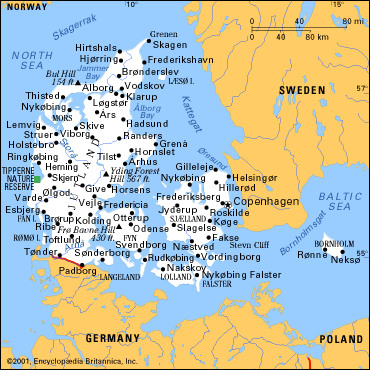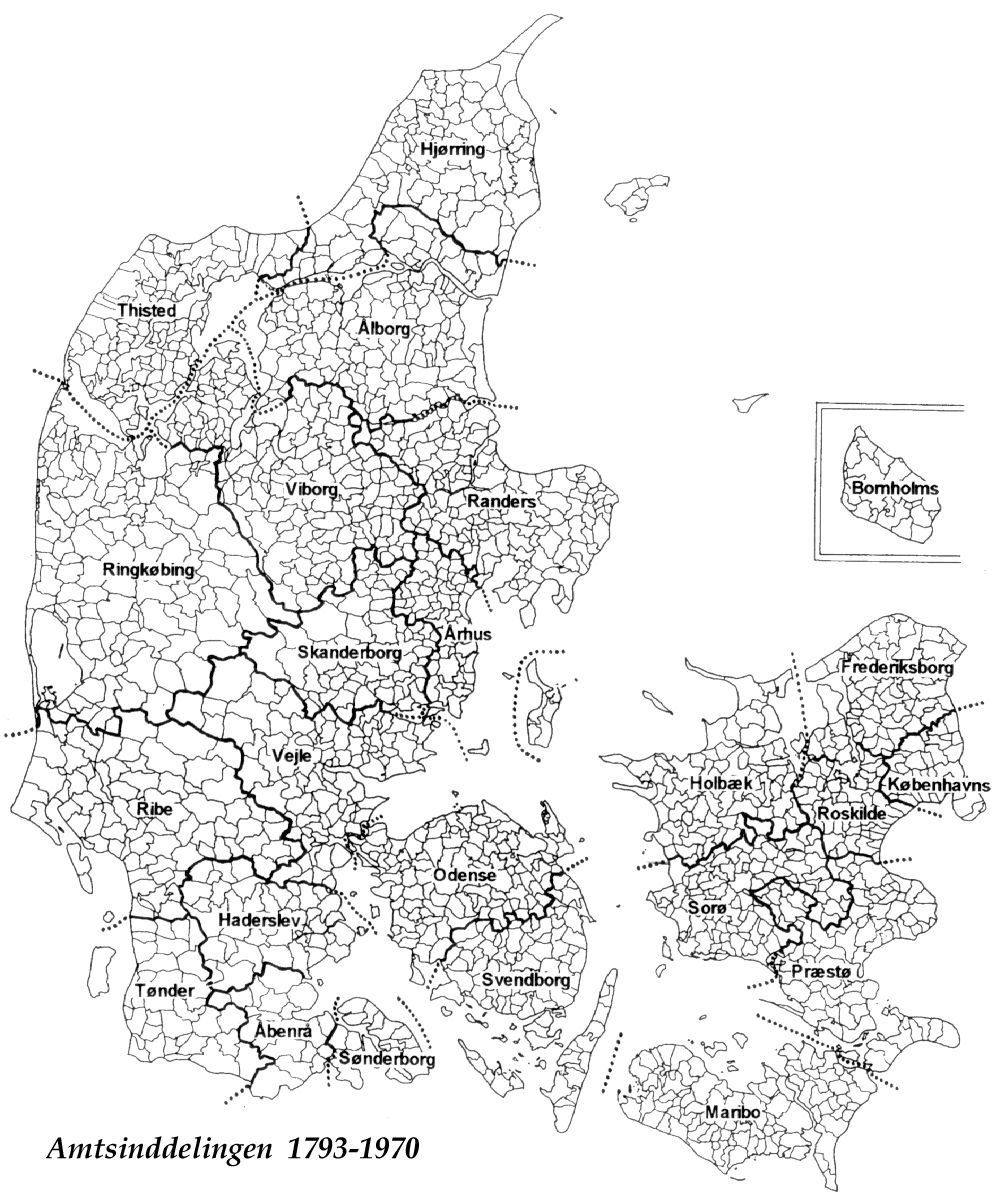|
Background Once the seat of Viking raiders and later a major north European power, Denmark has evolved into a modern, prosperous nation that is participating in the political and economic integration of Europe. So far, however, the country has opted out of some aspects of the European Union's Maastricht Treaty, including the new joint monetary system.
Flag of Denmark 
A traditional story claims that the Danish flag fell from heaven on June 15, 1219, but the imperial war flag of the Holy Roman Empire was of a similar design, with its red field symbolizing battle and its white cross suggesting divine favor. In 1849 this state and military flag was altered and adopted as a symbol of the Danish people.

Geography Smallest of the Scandinavian countries (half the size of Maine), Denmark occupies the Jutland peninsula, a lowland area. The country also consists of several islands in the Baltic Sea; the two largest are Sjaelland, the site of Copenhagen, and Fyn.
History From 10,000 to 1500 B.C., the population of present-day Denmark evolved from a society of hunters and fishers into an agricultural one. Called Jutland by the end of the 8th century, its mariners were among the Vikings, or Norsemen, who raided western Europe and the British Isles from the 9th to 11th century.
The country was Christianized by Saint Ansgar and Harald Blaatand (Bluetooth)the first Christian kingin the 10th century. Harald's son, Sweyn, conquered England in 1013. His son, Canute the Great, who reigned from 1014 to 1035, united Denmark, England, and Norway under his rule; the southern tip of Sweden was part of Denmark until the 17th century. On Canute's death, civil war tore apart the country until Waldemar I (1157-1182) reestablished Danish hegemony over the north.
In 1282, the nobles won the Great Charter, and Eric V was forced to share power with Parliament and a Council of Nobles. Waldemar IV (1340-1375) restored Danish power, checked only by the Hanseatic League of north German cities allied with ports from Holland to Poland. Denmark, Norway, and Sweden united under the rule of his daughter Margrethe in 1397. But Sweden later achieved autonomy and in 1523, under Gustavus I, independence.
Denmark supported Napolon, for which it was punished at the Congress of Vienna in 1815 by the loss of Norway to Sweden. In 1864, the Prussians under Bismarck and the Austrians made war on Denmark as an initial step in the unification of Germany. Denmark was neutral in World War I.
In 1940, Denmark was invaded by the Nazis. King Christian X reluctantly cautioned his fellow Danes to accept the occupation, but there was widespread resistance against the Nazis. Denmark was the only occupied country in World War II to save all its Jews from extermination, by smuggling them out of the country.
Beginning in 1944, Denmark's relationship with its territories changed substantially. In that year, Iceland declared its independence from Denmark, ending a union that had existed since 1380. In 1948, the Faeroe Islands, which had also belonged to Denmark since 1380, were granted home rule, and in 1953, Greenland officially became a territory of Denmark.
A referendum on the Maastricht Accord, which paved the way for greater EU economic integration, passed in May 1993. Denmark has been a member of the EC (now the EU) since 1973. On Sept. 28, 2000, Denmark voted to reject adoption of the euro, the European common currency.
More on Denmark....(click here) Learn Danish one word (and one day) at a time - Danish Word of the Day (CLICK HERE) 
Stats Official name: Kongeriget Danmark (Kingdom of Denmark).
Form of government: parliamentary state and constitutional monarchy with one legislative house (Folketing [179]).
Chief of state: Danish Monarch/Sovereign - Queen Margrethe II (1972)
Head of government: Prime Minister - Anders Fogh Rasmussen (2001)
Population (1998): 5,303,000.
Population projection: (2000) 5,340,000
Population (2001 est.): 5,352,815
Population projection: (2010) 5,506,000.
Natural increase rate per 1,000 population (1996): 1.3 (world avg. 15.7).
(average annual rate of natural increase: 0.1%); birth rate: 12.0/1000; infant mortality rate: 5.0/1000; density per sq mi: 322
Area: 16,639 sq mi (43,094 sq km) (Excluding Faeroe Islands and Greenland)
Land use (1994):
forested 10.5%;
meadows and pastures 7.5%;
agricultural and under permanent cultivation 55.9%;
other 26.1%.
Capital and largest city (1992): Copenhagen, 1,339,395
Other large cities (1992):
Arhus, 204,139;
Odense, 140,886;
Alborg, 114,970
Monetary unit: Krone
Languages:
Danish,
Faeroese,
Greenlandic (an Inuit dialect),
small German-speaking minority
Ethnicity/race:
Scandinavian,
Eskimo,
Faeroese,
German
Religions:
Evangelical Lutheran 91%,
other Protestant and Roman Catholic 2%,
other 7%
Literacy rate: 99% (1980)
Economic summary:
Gross national product (at current market prices; 1996): U.S.$168,917,000,000 (U.S.$32,100 per capita).
GDP/PPP (1999 est.): $127.7 billion; per capita $23,800.
Real growth rate: 1.3%.
Inflation: 2.5%.
Unemployment: 5.7%.
Arable land: 60%.
Agriculture: grain, potatoes, rape, sugar beets; beef, dairy products; fish.
Labor: 2.896 million; services, 71%; industry, 25%; agriculture, 4% (1997 est.).
Industries: food processing, machinery and equipment, textiles and clothing, chemical products, electronics, construction, furniture, and other wood products, shipbuilding.
Natural resources: petroleum, natural gas, fish, salt, limestone, stone, gravel, and sand.
Exports: $49.5 billion (f.o.b., 1999): machinery and instruments, meat and meat products, fuels, dairy products, ships, fish, chemicals.
Imports: $43.9 billion (f.o.b., 1999): machinery and equipment, petroleum, chemicals, grain and foodstuffs, textiles, paper.
Major trading partners: EU, Norway, U.S.
Communications:
Telephones: main lines in use: 3.203 million (1995).
Telephones - mobile cellular: 1.347 million (1999) .
Radio broadcast stations: AM 2, FM 355, shortwave 0 (1998).
Radios: 6.02 million (1997).
Television broadcast stations: 42 (plus 44 repeaters) (September 1995).
Televisions: 3.121 million (1997).
Internet Service Providers (ISPs): 12 (1999)
Transportation:
Railways: total: 2,859 km (508 km privately owned and operated) (1998).
Highways: total: 71,437 km; paved: 71,437 km (including 843 km of expressways); unpaved: 0 km (1998 est.).
Waterways: 417 km.
Ports and harbors: Alborg, Arhus, Copenhagen, Esbjerg, Fredericia, Grena, Koge, Odense, Struer.
Airports: 118 (1999 est.).
International disputes:
Rockall continental shelf dispute involving Iceland, Ireland, and the UK (Ireland and the UK have signed a boundary agreement in the Rockall area).
|